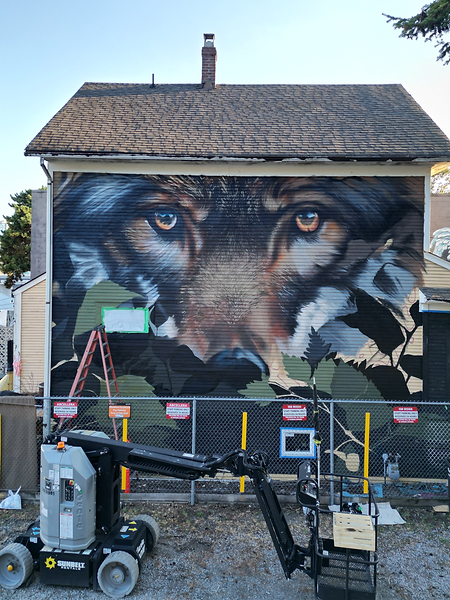heARTwork for wolves
Mural Artists, Dominic Laporte and Anaϊs Labrèque of DRIFT MURAL CO. create two stunning 30 x 35’ wolf murals, one at the Beaumont Studios in Vancouver's Mount Pleasant neighborhood and one on the side of Samurai Hardwood Flooring in Nelson.
Two large outdoor murals depicting wolves are now on display in British Columbia, one at the Beaumont Studios in Vancouver's Mount Pleasant neighbourhood and one painted on the side of Samurai Hardwood Flooring at 900 Simpson Rd in Nelson.
The paintings, created by talented artists, Dominic Laporte and Anaϊs Labrèque of Drift Mural Co., are financed by a coalition of NGOs, foundations and businesses.
The artwork aims to catalyze consideration of the essential role that wolves play in maintaining healthy ecosystems. The work will also portray the distinctive beauty of wolves, honed over millennia, to provoke reflection on their intrinsic value and sentient nature.
Both serve as a medium to invoke heightened awareness, education and inspiration to engage in a future that prioritizes coexistence and healthy landscapes for all species across BC.


Vancouver Mural Festival features wolf art
The non-profit, WeHowl, is hoping to raise awareness about BC's controversial wolf kill which has killed more than 2,000 animals since its launch in 2015.
Aug. 9, 2024

![20240820_155059[1].jpg](https://static.wixstatic.com/media/4bd11b_ee0216e155434bd7ac6d181e70cde796~mv2.jpg/v1/fill/w_422,h_563,al_c,q_80,enc_avif,quality_auto/20240820_155059%5B1%5D.jpg)
"The murals will help to convey the importance of maintaining large carnivores and functional predator-prey systems across BC; an opportunity that is diminishing worldwide."
- Sadie Parr, co-ordinator of the mural project and founder of WeHowl









